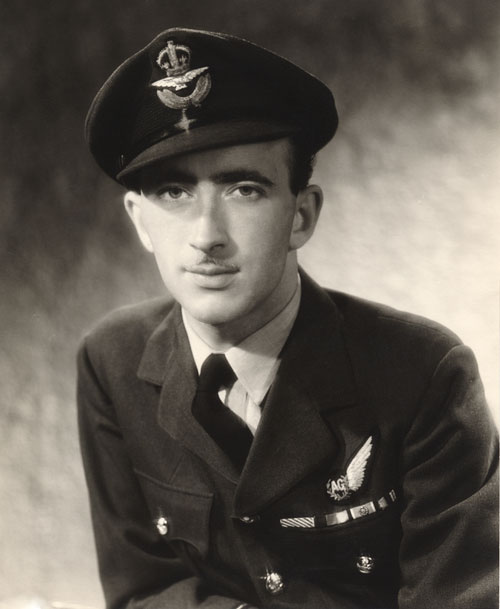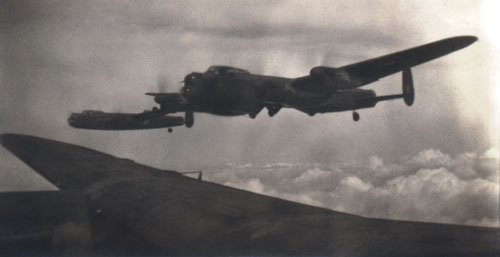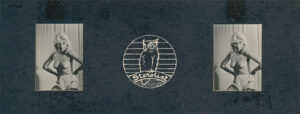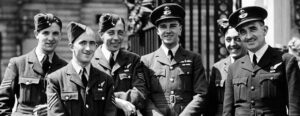As many of the readers of this blog know Douglas Webb was in the RAF. In fact, he was a bona fide war hero. Living in Leytonstone, experiencing the full effect of the blitz, he joined the RAF on his 18th birthday. Having to take a pilot’s induction exam he deliberately “made a nonsense of it” as he wanted to be a gunner. If he was going to war, he wanted a go at shooting the Bosche. He ended up a gunner in F/Sgt. Bill Townsend’s Lancaster in Squadron 49.

After finishing their tour the crew volunteered (minus the wireless operator who declined) for a secret mission. They joined what was to become Squadron 617 and their mission was Operation Chastise, now known as the legendary Dambuster’s Raid
They went to RAF Scampton to take part in ten weeks of intensive training, involving lots of cross-country low-level flying. They were first asked to fly at 150ft, then 100ft and finally 60ft. Doug knew it was going to be bloody dangerous. For one thing, the altimeter didn’t work that low. When Wing Commander Guy Gibson gave the pre-operational briefing the crews all saw where the red ribbons ended on the map: the most heavily defended area of Germany mockingly nicked named the Happy Valley. Doug was convinced he wasn’t coming back. After watching the first two waves take off, he returned to his quarters to take a bath. He wanted to die clean.

Taking off just after midnight F/Sgt. Townsend flew their plane AJ-Orange towards the heart of Germany. The flak was extremely heavy, as the enemy had been alerted by the first two waves of attack. Doug in the front turret hosed enemy positions with his machine guns. As he pumped away at their searchlights he was glad for the extra rounds he had “borrowed”. Lancaster AJ-Orange target was the Ennepe Dam, near Dortmund. With a thick mist rising from a wooded valley, they had difficulty in locating the target. Three times they overshot the dam. On the forth run at 3.37am, the bouncing bomb was released at less than 100ft above the water
As the plane circled the lake discharged a huge spout of water into the air followed by vast ripples spreading towards the Dam. It had fallen short, but they were pretty confident that the shock waves would do some damage. As they turned for home the fast approaching dawn made the return trip extremely dangerous. They could clearly see the breached Möhne dam and the Germans could clearly see them. Flying dangerously low, hugging the contours of the landscape, avoiding unexpected landmarks and pylons they flew through a barrage of distinctly unfriendly anti-aircraft fire.
When they got to the Dutch coast the Germans turned the large coastal guns on to them. The plane was badly damaged and one of its engines was knocked out, but taking evasive action they made it out to the safety of the North Sea. They arrived back to base at 6.15am. Flying downwind and into the sun they had a rather bumpy landing as the last plane back. Casualties were shockingly high. Eight of the original 19 Lancaster bombers were damaged or shot down, and of the 133 aircrew, 53 were killed and three captured.
As King George VI was in Africa it was the Queen Mother, then Queen Elizabeth who presented the squadron with their medals at Buckingham Palace on June 22, 1943. Doug was awarded the Distinguished Flying Medal.

After some time as a night vision instructor, Doug wangled his way back to 617 Squadron and flew on its last mission against Hitler’s Wolf’s Lair in Bavaria. Back on civvy street in 1946, he rejoined the London News Agency as a staff photographer, eventually going freelance and opening his own photography studio in Greek Street where he specialised in theatrical and film portraits as well as nudes. And that’s where he met Pamela Green.
Want to know more about Douglas Webb the Dambuster?
Check out the following posts:
- Dambuster of the Day No. 125: Douglas Webb
- Dambusters 70th Anniversary
- Dambusters 75th Anniversary
- Douglas Webb DFM (1922 – 1996)
- Douglas Webb — Shutterbug for the Heavy Mob (The Sweeney)
- Douglas Webb Sells His Medal
- Nude by Douglas Webb
- Operation Chastise 80th Anniversary
- Pamela Green by Douglas Webb
- The 3-D Xploits of Douglas Webb
- The Icon and Dambuster
- Wendy Toye’s The King’s Breakfas


his experience as a boy during the blitz goes to show the attitude of the British people during WW2, lets get the b****** back. not like the present day arm-chair historians who were not there and do nor understand and say was it worth it.
I was a boy and bombed in WW2, joined the RAF in 1950 and was a flight engineer on 617 in 1951, just before the Canberras.
New Doug Webb pictures of Pamela Green and Just Jane | on the Dambusters Blog.
http://dambustersblog.com/2014/09/14/new-doug-webb-pictures-of-pamela-green-and-just-jane/
my sister Bebe took me to Dougs studios,I still have 6 of the photos that were taken. I was about 3.y.o
my sister celebrated her 91st birthday on 5th april this year.
(2015). I have read that Doug and Len Sumpter were the only
members of 617 to be on the first and last operations!
Oh wow.That’s so great. Do remember where the studio was?
somewhere off fleet street,not exactly sure